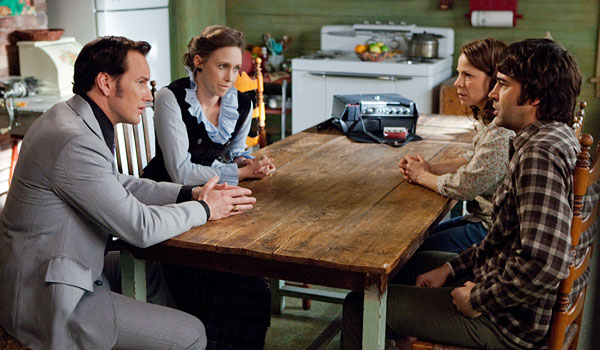
Fright Week: The Moviola Review: The Conjuring
Written by: Drew Morton, Special to CC2K
For CC2K’s Fright Week, The Moviola’s own Drew Morton reviews one of the scariest films ever made: James Wan’s The Conjuring. Don’t forget to enter our giveaway for a Blu-ray copy of The Conjuring.
There’s no doubt that James Wan’s latest horror film The Conjuring (2013) will scare the crap out of you. The film was given an R rating by the MPAA – not for gore or swearing or nudity (sorry, teenage boys!) – but for its sheer relentlessness. From a haunted house at the fair standpoint, The Conjuring is meticulously designed. Its scares are “old fashioned” in the use of sound and the permeable boundary between on-screen and off-screen space. Creepy, possessed, dolls and clapping hands lurk in every black recess of the frame. Despite my age and my familiarity with the horror genre, I still let out a handful of audible screams. It’s fun and scary. But does that make it a good film?

With their backs up against the wall, the Perrons turn to Ed (Patrick Wilson) and Lorraine Warren (Vera Farmiga), the two paranormal “demonologists” who worked on the Amityville Horror case. Their gift for supernatural investigation stems from their faith in God and Lorraine’s ability to have psychological visions (basically, she has Danny’s gift from The Shining). The Warrens investigate the house and – as usual – determine that something horrible has happened there and that the house needs to be exorcised from evil spirits.
It is the family dynamic that The Conjuring fails to establish. Despite running two hours (long for a horror film) and showcasing technical bravura, the familial relationships are thin at best. For instance, we hardly get to know the kids in the Perron family. I do not recall ever getting a formal introduction to them and they are vaguely defined along the lines of “that’s the kid that sleepwalks” and “that’s the kid that has a crush on the boy helping the Warrens.” More frustrating is the relationship between Ed and Lorraine. The film establishes that the family is driven by a faith in God and that Ed fears for his wife’s sanity due to her psychological gifts. First, the screenplay handles the faith angle in a very hamfisted way with dialogue exchanges like “Do you remember the thing you said on our wedding night?” “Can we do it again?” “No! The other thing. That God brought us together for a reason!” Moreover, Ed repeatedly expresses his concerns, worrying that she might “bring something back.” This becomes a major plot point during the third act… Or at least it becomes a major set up that Wan just skates over in favor of more of the same scares.

Essentially, given the cast and Wan’s gift for film form, what makes The Conjuring a disappointment is that we hardly know anything about these people. Because of that, our fear is one step removed from the action. Films like The Shining (1980) and The Descent scare us because we can identify with the characters. In the case of both films, they terrify because they both have established a darkly inhabited space that characters with real motives, relationships, and conflicted desires have found themselves within. The Conjuring scares and dazzles simply through formal means. Essentially, it’s like watching the ghosts of what could fully realized characters flee from other ghosts. It’s fun for a little while…until it isn’t.
